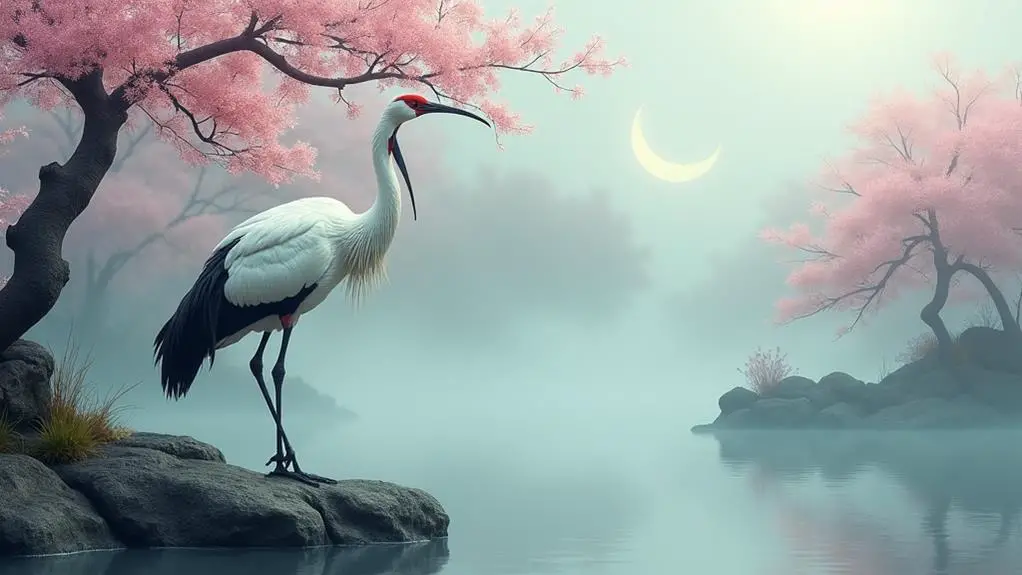As you explore the intricacies of Asian culture, you'll likely encounter the majestic crane, a symbol steeped in history and significance. In Japan and China, this elegant bird represents longevity, wisdom, and good fortune. But its symbolism goes far beyond these surface-level interpretations. By examining the crane's role in ancient mythologies, modern-day celebrations, and cultural traditions, you'll begin to unravel a complex web of meanings that can inform your understanding of Asian culture and even personal growth. But what specific stories and traditions have contributed to the crane's revered status, and what can you learn from them?
Key Takeaways
- Cranes symbolize good fortune, longevity, and wisdom in ancient Chinese, Greek, and Norse mythologies.
- In Japanese culture, cranes represent good luck, longevity, and peace, particularly during the Japanese New Year (Oshogatsu).
- The crane's remarkable life span and unique mating habits contribute to its symbolic meanings in Chinese culture.
- Cranes are often depicted in art and literature as a symbol of harmonious bonds, long-lasting relationships, and adaptability.
- The crane's association with spiritual growth, inner peace, and longevity resonates deeply with individuals seeking balance and harmony in their lives.
Origins of Crane Symbolism
The origins of crane symbolism date back to ancient cultures, where you can find evidence of this majestic bird's significance in various forms of art, literature, and folklore.
In many ancient myths, the crane is often depicted alongside mythical creatures, such as dragons and phoenixes, symbolizing good fortune and prosperity.
The crane's majestic appearance and impressive wingspan made it a revered creature in many ancient societies.
You can find evidence of crane symbolism in ancient Chinese, Greek, and Norse mythologies.
In these cultures, the crane was often associated with longevity, wisdom, and spiritual growth.
In some myths, the crane is depicted as a messenger between the mortal world and the realm of the gods, emphasizing its importance as a symbol of communication and connection.
The crane's symbolism has evolved over time, influenced by various cultural and historical contexts.
By exploring the origins of crane symbolism, you can gain a deeper understanding of the cultural significance of this majestic bird and its enduring presence in art, literature, and folklore.
This understanding will serve as a foundation for further exploration of the crane's symbolism in different cultures and contexts.
Crane Significance in Japan
When exploring the significance of cranes in Japan, you'll find they're deeply rooted in the country's traditions and celebrations.
During the Japanese New Year, or Oshogatsu, the crane is often featured in decorations and gifts, symbolizing good luck and longevity.
In Japanese culture, cranes are also closely tied to marriage, with the thousand origami cranes folded by a bride representing a wish for a thousand years of happiness and prosperity with her partner.
Japanese New Year
Midnight New Year's festivities in Japan, or 'Oshogatsu,' kick off a 15-day celebration steeped in tradition and symbolism.
You'll notice the crane's significance during this time, particularly in Japanese customs surrounding new beginnings. The crane is a symbol of good luck, longevity, and peace, making it a popular motif during Oshogatsu.
In Japan, the New Year is a time for renewal and fresh starts.
You'll see the crane featured on New Year's cards, decorations, and even food packaging. The crane's elegant design and majestic appearance make it a popular choice for expressing well-wishes and good fortune.
As you participate in Japanese New Year's festivities, you'll likely come across the crane in various forms, from traditional artwork to modern designs.
The crane's presence during Oshogatsu serves as a reminder of the importance of peace, harmony, and good fortune in the coming year.
Longevity and Marriage
Japanese culture associates cranes with a long and happy life, particularly in marriage and family.
When you think of crane symbolism in Japan, you might imagine elderly couples enjoying peaceful strolls together, which isn't far from the truth.
Cranes are often depicted in art and literature as a symbol of harmonious bonds and long-lasting relationships.
In the context of marriage, cranes are believed to bring good fortune and longevity to the union.
This is reflected in many Japanese wedding traditions, where cranes are often featured in decorations and gifts.
Some key aspects of crane symbolism in Japanese marriage and family include:
- Elderly unions: Cranes are often depicted as elderly couples, highlighting the importance of long-term relationships and companionship in old age.
- Harmonious bonds: Cranes are believed to represent the harmony and balance that are essential for a successful marriage.
- Family ties: Cranes are also associated with family unity and the importance of strong family bonds, which are deeply valued in Japanese culture.
Chinese Crane Symbol Meanings
When exploring Chinese crane symbolism, you'll find that it's closely tied to longevity and wisdom, good fortune, and auspicious marriage signs.
The crane's association with these concepts stems from its remarkable life span and unique mating habits.
You'll discover that the crane's representation in Chinese culture often signifies a long, happy, and prosperous life, making it a highly revered and symbolic creature.
Longevity and Wisdom
In Chinese culture, the majestic red-crowned crane is often depicted in art and literature as a powerful symbol of longevity and wisdom.
When you see a crane in Chinese art, you're likely to associate it with elderly wisdom, as it's said to live for thousands of years. This legendary longevity has led to the crane becoming a symbol of wisdom gained through life experiences.
The crane's association with wisdom is also tied to its unique characteristics.
As a bird that migrates to different parts of the world, it's seen as a symbol of adaptability and resilience. You can learn valuable life lessons from the crane's ability to thrive in different environments.
- The crane's longevity represents the importance of learning from past experiences and passing on knowledge to future generations.
- Its annual migrations symbolize the need to adapt to changing circumstances and be open to new experiences.
- The crane's gentle nature, despite its size, reminds you to approach challenges with humility and wisdom.
Good Fortune Symbolism
You're likely to notice another prominent symbolism associated with the red-crowned crane in Chinese culture – its representation of good fortune.
This symbolism stems from the crane's majestic appearance, gentle nature, and impressive physical abilities.
In Chinese culture, the crane is often depicted with other symbols of good fortune, such as bamboo and plum blossoms, to emphasize its association with prosperity.
As a symbol of good fortune, the red-crowned crane is often used as a prosperity charm in various forms, including statues, paintings, and ornaments.
These objects are believed to attract wealth and good fortune to those who possess them.
In Chinese business culture, the crane is considered a wealth magnet, attracting financial success and prosperity.
Many entrepreneurs and business owners display crane symbols in their offices or homes to invite good fortune and prosperity.
The crane's association with good fortune is also reflected in Chinese art and literature, where it's often depicted as a benevolent creature that brings prosperity and happiness to those around it.
Auspicious Marriage Sign
As the red-crowned crane's majestic presence commands respect, its symbolism in Chinese culture extends to auspicious marriage signs, where it's believed to bring good luck and prosperity to newlyweds.
When you see the crane in the context of marriage, it's often depicted in pairs, signifying the union of two people coming together in harmony.
In Chinese culture, the crane is thought to be a symbol of a long-lasting and happy marriage, which is why it's often featured in wedding decorations and ceremonies.
- The crane's long neck is said to represent the connection between the couple, with the male and female crane being able to communicate effectively through a series of calls.
- The crane's white feathers symbolize purity and innocence, which are highly valued in a marriage.
- The crane's ability to mate for life is seen as a symbol of Eternal Union, where the couple is committed to each other for the rest of their lives.
Incorporating the crane into your wedding celebrations can be a beautiful way to wish for Marriage Harmony and a lifelong commitment to each other.
Crane Representations in Art
Silent observers of the natural world, cranes have long been a source of fascination for artists across cultures.
You'll find them depicted in various art styles, each conveying unique aspects of crane symbolism. In traditional Japanese ukiyo-e woodblock prints, cranes are often shown in serene landscapes, emphasizing their association with longevity and peace.
In contrast, Chinese paintings frequently feature cranes amidst vibrant, dynamic compositions, highlighting their symbolism of good fortune and prosperity.
As you explore crane representations in art, you'll notice the emphasis on visual storytelling.
Artists use the crane's majestic form, gentle movements, and striking plumage to convey narratives and themes. For instance, a pair of cranes may be depicted in a harmonious dance, symbolizing marital bliss and fidelity.
The use of vibrant colors, delicate brushstrokes, and intricate patterns adds depth and texture to the artwork, drawing the viewer into the narrative.
By examining crane representations in art, you gain insight into the cultural significance of these majestic birds and the values they embody.
Through art, the crane's symbolism is preserved and transmitted across generations.
Cultural Associations and Folklore
Beyond the art world, crane symbolism extends into the realm of cultural associations and folklore.
In many Asian cultures, you'll find the crane associated with mythic creatures and revered as a symbol of good fortune and longevity. Its majestic appearance and graceful movements have led to its depiction as a sacred messenger between the mortal world and the realm of the gods.
As you delve deeper into the cultural significance of the crane, you'll discover a wealth of folklore and myth surrounding this majestic bird.
- In Japanese folklore, the crane is said to live for 1,000 years, making it a symbol of longevity and wisdom.
- In Chinese culture, the crane is associated with the goddess of immortality, Xi Wangmu, and is often depicted as her sacred messenger.
- In Hindu mythology, the crane is linked to the god of creation, Brahma, and is said to have carried the god's sacred texts to the mortal world.
Crane in Korean Culture
Embracing a rich cultural heritage, Korea has a profound respect for the crane, which is deeply rooted in the country's mythological and symbolic traditions.
As you delve into Korean folklore, you'll find that the crane is an integral part of the nation's storytelling, often depicted as a messenger between the mortal world and the divine realm. Korean mythology associates the crane with good fortune, longevity, and happiness.
You'll notice its presence in various Korean art forms, including traditional paintings, pottery, and embroidery.
The crane's significance in Korean culture is also reflected in the country's cultural heritage, with the bird featuring prominently in traditional festivals and rituals.
In Korea, the crane is considered a sacred animal, often associated with the gods and revered for its majestic beauty. You'll find that the crane's image is often used in Korean architecture, literature, and poetry, symbolizing wisdom, loyalty, and devotion.
Symbolic Meanings in Modern Life
As the cultural significance of the crane has continued to evolve over time, its symbolic meanings have been adapted and reinterpreted in modern life.
You may find the crane's symbolism inspiring, as it embodies qualities that are highly valued in today's fast-paced world.
The crane's association with spiritual growth, inner peace, and longevity resonates deeply with individuals seeking balance and harmony in their lives.
In modern life, the crane's symbolic meanings can be applied in various ways.
You can reflect on the crane's qualities and how they relate to your personal growth and aspirations.
- Embodying the crane's patience and perseverance, you can cultivate a stronger sense of resilience and determination in the face of challenges.
- By embracing the crane's emphasis on inner peace, you can prioritize self-care and mindfulness in your daily life.
- The crane's association with spiritual growth can inspire you to explore your own spirituality and connection to the world around you.
Frequently Asked Questions
Can Cranes Symbolize Bad Luck in Any Asian Culture?
You might think cranes are always auspicious, but in some Asian cultures, they can symbolize bad luck. You'll find cranes serve as dark omens or unlucky messengers, foreshadowing death or disaster, in certain Japanese and Korean traditions.
How Do Asian Cultures View Crane Mating Rituals?
You'll find that in Asian cultures, mated pairs of cranes are often viewed as models of fidelity, with their mating rituals symbolizing lifelong vows and monogamous relationships, representing a deep commitment to one another.
Are Cranes Associated With a Specific Asian Deity?
You explore Asian deities associated with cranes, finding connections to Japanese Kami, specifically Benzaiten, the goddess of beauty, and Chinese Immortals, like the Eight Immortals, often depicted with cranes, symbolizing longevity and wisdom.
Can Cranes Symbolize Longevity in Non-Asian Cultures?
You'll find that cranes symbolize longevity beyond Asian cultures, appearing in Greek mythology as a symbol of vigilance and in Celtic folklore as a representation of longevity, wisdom, and good fortune, signifying a deeper connection.
Are Cranes Considered Sacred in Buddhist Traditions?
In Buddhist traditions, you find that cranes are considered sacred, as depicted in Buddhist scriptures and reinforced by Crane mythology, which symbolizes good fortune, longevity, and spiritual growth, reflecting their revered status.
Conclusion
As you conclude your exploration of crane symbolism in Asian culture, you're left with a profound question: will you harness the crane's wisdom to elevate your own life? With its symbolism of longevity, wisdom, and good fortune still resonating, you're poised to embark on a transformative journey. Will you tap into the crane's power to cultivate patience, resilience, and inner peace? The crane's secrets await – the next step is yours.





